The Largest Wildflower Meadow in Dallas
 |
| Acres of marsh loving Clasping Coneflower (Rudbeckia amplexicaulis) as far as the eye can see in the Back Forty below Big Spring in the Great Trinity Forest; Dallas, Texas |
Across a flooded slough from Big Spring in the Great Trinity Forest sits the largest wildflower meadow inside the city limits. Horizon to horizon, millions and millions of Clasping Coneflower (Rudbeckia amplexicaulis) bloom for a few weeks in May. The bright yellow flowers glow a radiant color that a camera just cannot capture. Varying from brilliant gold to a pale mustard the field shimmers bright like a yellow sea.
 |
| Indigo Bunting in the meadow |
The meadow down here stays wet many months of the year. Matter of fact on the day when the photo above was taken the field had a half inch of water across it. Clasping Coneflowers thrive in this wet environment. In scientific jargon, the colony of flowers is given the term “monoculture” noting a dominance of one species. Peppered here and there are an Indian Blanket or some Primrose. But the coneflower dominates. No one seeded them or planted them. It’s a gift. For leaving the place alone.
 |
| Evening Primrose mixed in among Clasping Coneflower |
 |
| Shafts of early evening sun through clouds |
It’s a special spot. If there is another like it I do not know of it.
This field is known as a transitional meadow and occurs when a field, pasture, farmland, or other cleared land is no longer grazed by livestock and starts to display growth extending to the flowering and seeding of its grass and wild flower species. The condition is however only temporary because the grasses eventually become shaded out when scrub and woody plants become well-established, being the forerunners of the return to a fully wooded state. That could happen here at some point.
A wet meadow is a semi-wetland meadow which is saturated with water throughout much of the year. Some experts consider a wet meadow to be a kind of marsh, while others consider it to be a distinct type of wetland. Wet meadows may occur because of restricted drainage or the receipt of large amounts of water from rain. They may also occur in riparian zones and around large rivers like the Trinity.
Unlike a marsh or swamp, a wet meadow does not have standing water present except for brief to moderate periods during the growing season. The ground in a wet meadow fluctuates between brief periods of flooding and longer periods of wetness. Wet meadows often have large numbers of wetland plant species, which frequently survive as buried seeds during dry periods, and then regenerate after flooding. Wet meadows therefore do not usually support aquatic life such as fish. They typically have a high diversity of plant species, and may attract large numbers of birds, small mammals and insects including butterflies.
Speaking Of Wet
It was 105 years ago today. May 26, 1908. A hot and steamy day when a forefather of Billy Ray Pemberton drove a spike into a trunk of a walnut tree at Big Spring to mark the crest of the greatest flood in recorded Dallas history. The Big Flood. It was a date that has long been remembered in Dallas, forever changing the course of a city and the river that runs through it.
 |
| Original Trinity Riverbed May 26, 2013 |
The city in that 105 years changed in ways Billy Ray’s grandfather probably never could have imagined. Skyscrapers, highways, air travel and communication at light speed.
Vowing to never again let the Trinity get the better of the city, planners and engineers moved the river. Channelized it in a system of levees and pump stations leaving the old river channel dry.
 |
| High water mark of 1908 flood in Design District |
That old channel still exists, a wide damp spot snaking through the Dallas Design District. A small plaza sits on Turtle Creek Blvd with a symbolic I-beam spike driven vertically into the old river bank. The top of that blue painted steel marks the high water mark of that epic flood. Two miles wide and 52 feet deep.
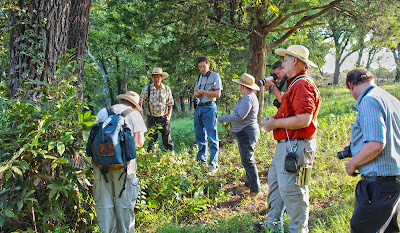 |
| High water mark of 1908 flood at the Pemberton Farm |
What has not changed since that time over a century ago is that spike, that tree and the natural spring that it has sat next to, since time immemorial. The acreage around it largely unspoiled and a reminder of what Dallas once looked like before the city planted it’s own roots.
That old Black Walnut is one of the focal points of any visit to Big Spring. Sitting just out of the 100 year flood plain the tree is a mere twenty feet north of the spring and in an integral part of the “Spring Complex” as it is called. Your city government does not think so.
That city government wants to fence the Spring off. Wants to build a fence that would separate that old tree from the Spring that it has forever been with as a part of a Historic Texas landscape. They want the wildflower meadows for hay. They want to bulldoze through the woods for trails. Pave parts of the sloughs and swamps for concrete paths. Being nice and oh so cordial the way we Texans lean towards is very tough when it comes to the city and their plans. Bless their hearts. For they know not what they are doing. Sure of that now.
The voices of reason are beginning to step forward to get the message across about the unique nature of such a place. Questions are being asked for which the answers will be hard to find. Where that leads is unknown to me.
The plight of the spring and the Native American site around it is gaining quite a bit of attention in the media too. Jonathan Betz from Channel 8 paid a recent visit and even drank from the Spring. Mr Pemberton as is his custom will bestow honorary Pemberton status to those who drink from it.
WFAA Channel 8’s Jonathan Betz reports on Big Spring
Mr Pemberton has a joke he pulls on guests to the Spring. He’ll butter folks up to take a swig of his water. A little prodding and a little bit of encouragement is all it takes. Then he’ll throw a boomerang and talk about the livestock he chased out of there just an hour before or a tall tale about some contaminant. None of that is true of course, just his way of pulling leg. It comes through in his story that aired. Since then his wife, Zada, was concerned people would get the wrong idea and not understand his kidding humor. The water is perfectly clean and safe. Just to set the record straight.
 |
| Turtle in Big Spring, May 2013 |
The city seems it would like to discount much of the history and special nature here. Very clear that some facts are being ignored by the city government in an effort to pursue construction of future projects. The city has leaned heavily on an archeological report published in 2009 that is full of errors and factually incorrect. Using that report, the city is trying to downplay the history at the site and the Native American artifacts that lie buried beneath. Part of that answer to the truth lies in the deep dusty vaults of archeological archives in Austin by artist and archeologist Forrest Kirkland. A place scientists call DL72. We call it Big Spring.
The Legacy Of Forrest Kirkland
 |
| Forrest Kirkland at his desk detailing Native American wall art renderings in his studio, Dallas, Texas |
 |
| DL72 report by Forrest Kirkland; Credit: Tim Dalbey |
In the 1930s local Dallas artist Forrest Kirkland made a name for himself illustrating commercial catalogs for industrial equipment and machinery. His commercial work paved the way for his pursuit of his real passion, Native American rock art and ancient wall paintings. Taking his expertise in cataloging and illustrating the physical world he became a foremost expert in Texas Native American sites.
A resident of Dallas, his weekend field trips often led him down White Rock Creek and the Trinity River, where he documented two hundred ancient sites in the 1930s and early 1940s in Dallas County. One site of note was DL72, the Big Spring site. His excellent documentation provides great insight into Native American artifacts at Big Spring. His field notes describe a trip taken on December 29, 1940 to Big Spring and accompanying sketches noting a large Native American site that extends north to south along a natural terrace hundreds of yards long. In addition, a note about a farmer finding a human grave near the spring, most likely Native American in origin.
Texas Parks and Wildlife has an excellent article from 2008 on Forrest Kirkland that is worth a read entitled The Shaman’s Scribe: Artist Forrest Kirkland helped preserve Texas pictographs by trekking to remote sites and painting meticulous reproductions
 |
| Forrest Kirkland sketching Native American rock art on the Pecos |
Forrest Kirkland created paintings based on the physical sites he visited, many of the rock art images he recorded have since been destroyed or damaged. When Amistad Reservoir was completed in the 1960s, many Lower Pecos rock art sites disappeared beneath the waves. Other rock art sites have been damaged by vandals or by natural disasters such as major floods. He passed away from a heart attack in 1942. His legacy lives on his paintings, drawings and detailed study of Native American sites in Texas.
The sites he documented in Dallas are subject not to inundation of a reservoir, weathering or vandalism. The threat is one of unchecked construction and development. Many Dallas County sites were lost this way. Very few exist.
Important Sites Still Exist
 |
| Native American artifacts from DL72 Credit: Tim Dalbey |
The DL72 site consumes much of the Spring Pasture, a 20-30 acre plot of land that serves as a biofilter buffer for the perched aquifer Spring from surface contamination. Since that day in 1940, only one professional archeological survey has been completed. That involved some scant shovel testing in a widely spaced matrix. Native American artifacts were found here and there and should have warranted more excavation. That did not happen. But should.
The extreme southern portion of the site, which now sits in a plat of land at 811 Pemberton Hill Road will one day house the Texas Horse Park. That portion of the archeological site was partially tested in January of 2013 revealing a treasure trove of artifacts that offer a small glimpse of what is still buried there. In the photo above taken by geoarcheologist Tim Dalbey who assisted with the archeological dig, one can see the variety of tools, points and artifacts the site is yielding. This summer, further investigation is planned using trenching which should provide a more in depth look at the site. Very exciting and one can only hope that the rest of the site that sits to the north near Big Spring is afforded the same professional examination.
DL72 is one of the very last Native American sites left in Dallas. If fully excavated, it would be one of the only Native American sites ever professionally and scientifically studied inside the city limits. The Last of the Mohicans, you might say.
Beyond Big Spring — The Big Swamp
 |
| Beaver Dam on Bryan’s Slough/Oak Creek |
The city has expressed a desire to build concrete trails and horse paths into an area which from aerial photos appears to be a dry woodland. Wrong! Fooled me too. It’s a permanent swamp year round and the uninitiated will find themselves in hip deep water very quickly. North of 175 the place has been dubbed Bruton Bottoms, south of 175 it has no name.
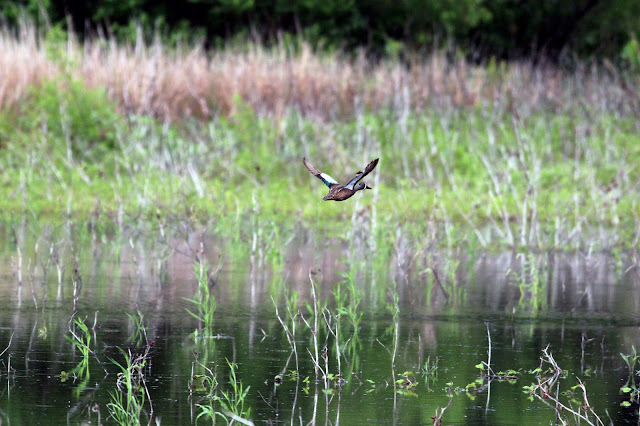 |
| Blue Winged Teal over the swamp May 25, 2013 |
 The water here is clear. A mix of spring fed creeks, drainages and slow moving water the swamp creates an ideal habitat for all kinds of wildlife. It will put you out of your comfort zone. Mosquitoes, floating fire ant balls and snakes are the norm. So are the rare glimpses of wildlife so few have ever seen.
The water here is clear. A mix of spring fed creeks, drainages and slow moving water the swamp creates an ideal habitat for all kinds of wildlife. It will put you out of your comfort zone. Mosquitoes, floating fire ant balls and snakes are the norm. So are the rare glimpses of wildlife so few have ever seen.
I have no clue how the city would even engineer a trail across this place. They would need to de-water the area by trapping the beavers, dynamiting their dams and then channelize the sloughs down here to dry it out. Even then the frequency of flooding would compromise all that.
 |
| Great Blue Heron over Bryan’s Slough, May 2013 |
The city wants to build a concrete trail across the slough exactly where that Great Blue Heron is pictured above. It would remove a great old beaver dam that is currently in use. The trail would link to Lake June Road. This is a very wet place and just gets wetter the further in one travels.
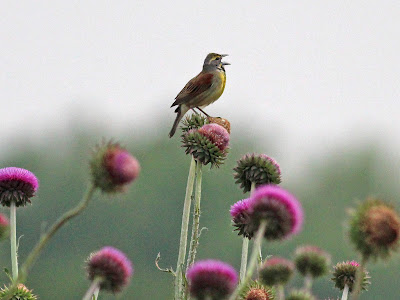 |
| Dicksissel (Spiza americana) in full breeding plumage May 2013 |
So far, the majority of concrete trails in the Great Trinity Forest follow old dirt roads, are built on levees, utility right of ways or old landfills. Now that those trails are built-out, the next phase of concrete trails will enter unspoiled wilderness areas in the Great Trinity Forest where man has never built.
It will be a hard task to prove that trails cannot be built here. The inundation of constant floods coupled with the high maintenance costs of clearing flood debris will be exponential compared to that of other paved paths in Dallas.
The Threatened White Faced Ibis flock on Bryan’s Slough
 |
| White Faced Ibis on Bryan’s Slough with a building severe thunderstorm in the distance May 25, 2013 |
Rare birds call this place a summer home. Listed in Texas as a Threatened Species, the White Faced Ibis is a very rare sight to Texans. To Dallasites the bird is very rarely if ever seen. A “life bird” for many who keep a checklist, seeing one in the wild would be a year’s highlight for many birding types.
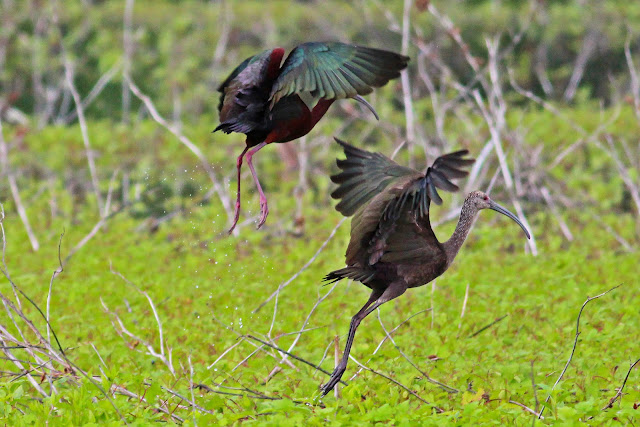 |
| Juvenile White Faced Ibis foreground and Adult White Faced Ibis in full breeding plumage background, May 25, 2013 |
 |
| Water snake hiding in the swamp roots |
The White Faced Ibis is threatened due to habitat loss. It needs wetland areas exactly like those along Bryan’s Slough and Oak Creek to thrive. The shallow wading pools in short grasses, flooded marsh and lowland areas are their prime habitat. Very few of these places still exist. It’s a real gem to have one here in Dallas. I fear it would be forever ruined by a concrete path that would surely interrupt the flow of water to some of these grassy fields needed as habitat for this Threatened Species.
 |
| Black-necked Stilt in Bryan’s Slough |
Under a quickly building set of severe thunderstorms I found these birds far back in an area visited by few on two legs. The air was electric with lightning and sky quickly darkening. Most would run for home. Far from a road, far from anything remotely resembling dry land, I rode the sets of storms out at the base of a tree.
There are always a special few minutes when the air smells of ozone and rain. These pictures are from those rare minutes before the heavens open up.
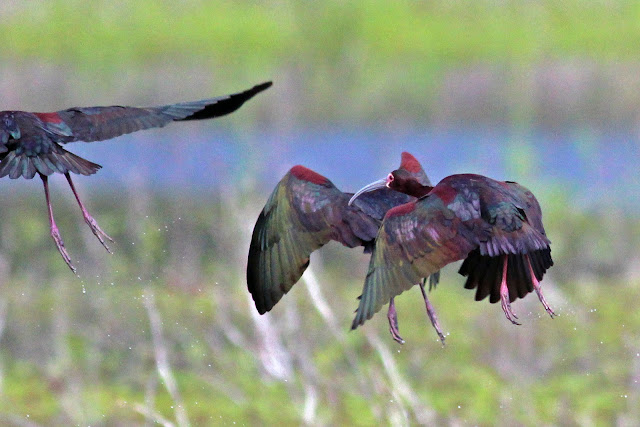 |
| Flock of White Faced Ibis taking to the air at the clap of thunder, Dallas, Texas May 25, 2013 |
 Easy to make a case why this place should just be left alone. The hard part is proving why it should be changed.
Easy to make a case why this place should just be left alone. The hard part is proving why it should be changed.
So few places like this have ever existed in Dallas County. Even before the pioneers, the ancient Texans saw this as a special place. The ones whose language coined the term Texas from their word for friend, Tee-has “tejas”.
 |
| A rare yellow Indian Blanket flower |
 It’s hoped that this rough spot, the growing pains of a large government project to change the land down here can some how leave the land in this corner of the Great Trinity Forest alone.
It’s hoped that this rough spot, the growing pains of a large government project to change the land down here can some how leave the land in this corner of the Great Trinity Forest alone.
Hal and Ted Barker have setup a Facebook page that keeps up with the day to day notes on preserving this part of the Trinity:
https://www.facebook.com/SavePembertonsBigSpring
They are also in the middle of a large documentation of the Trinity River Project that is taking them some interesting places via Open Records Act. That can be followed here:
http://pavethelake.wordpress.com/
I believe some of the records they have requested hope to shed light on the alleged illegal dumping at the city owned property next door which has heavily contaminated the soil at the site of the future Texas Horse Park. The Barkers are the good guys and looking to protect everyone involved in bringing the truth out in the open.




